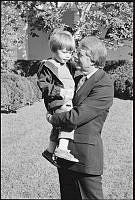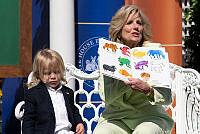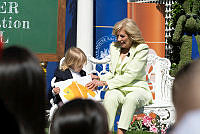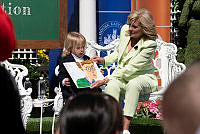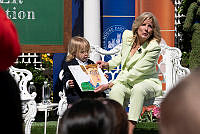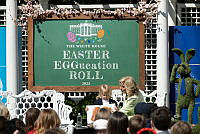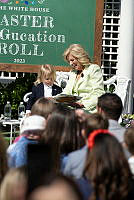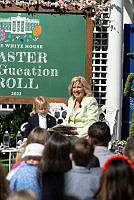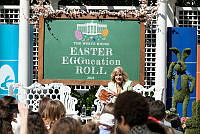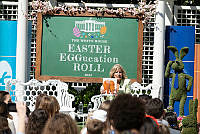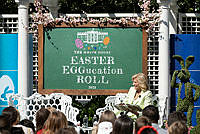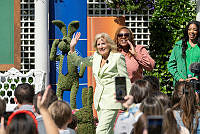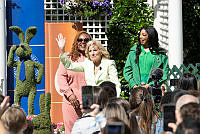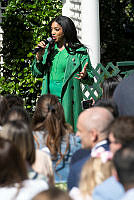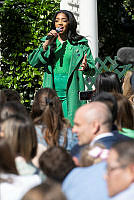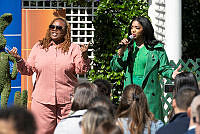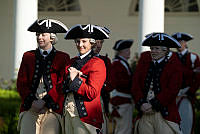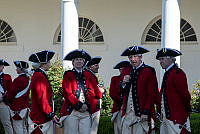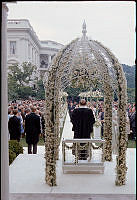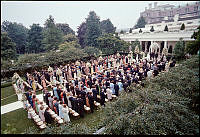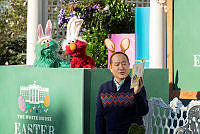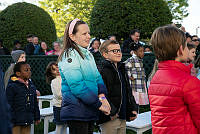Rubenstein Center Scholarship
Landscapes & Gardens
- John Adams was the first president to occupy the White House in 1800; one of his first additions was a vegetable garden.
- In 1801, Thomas Jefferson was active in planning improvements for the Executive Mansion (White House) garden, including a stone wall around the house. He also directed the planting of numerous trees between 1802 and 1806.
- While the White House was being rebuilt after the 1814 fire, James Monroe increased tree plantings on the grounds based on plans by architect Charles Bulfinch.
- Pennsylvania Avenue did not originally cross in front of the White House. The area was a public common used for fairs and parades. In 1822 the avenue was cut through the north side of the President's Park and soon thereafter Lafayette Park was established.
- The federal government used Charles Bulfinch's planting scheme for a thick grove of trees for the square north of the White House and named the park in honor of General Lafayette in 1824-1825.
- In 1825, John Quincy Adams developed the first flower garden on the White House grounds and planted ornamental trees.
- Andrew Jackson created the White House orangery, an early type of greenhouse where tropical fruit trees and flowers can be grown, and added more trees, including the famous Jackson magnolia, to the White House grounds in 1835.
- President James K. Polk placed a bronze statue of Thomas Jefferson by P. J. David d'Angers on the North Lawn in 1848. It stood there for 27 years before being moved to the Capitol and was the only monument to a president ever to stand within the immediate enclosure of the White House.
- In 1850, the noted landscape gardener Andrew Jackson Downing developed a landscape plan for the President's House and the Mall.
- Sculptor Clark Mills's famous equestrian statue of Andrew Jackson was unveiled in the center of Lafayette Park in 1853.
- In 1853, during the administration of Franklin Pierce, the White House orangery was expanded into a greenhouse.
- In 1857, workers demolished the White House orangery to make way for a new wing for the Treasury Department; a replacement greenhouse was constructed on the west side of the White House, adjoining the State Floor.
- East and West Executive Avenues were built on each side of the White House as public streets in 1866 and 1871.
- In 1867, the West Wing conservatory was destroyed by fire; government architect Alfred B. Mullet designed and built a more fireproof iron frame and wood sash replacement.
- In the 1870s, President Grant had a billiard room built between the greenhouse and the mansion.
- In the 1870s, Ulysses S. Grant directed the expansion of the grounds to the south and built round pools on the North and South lawns.
- From 1878 to 1880, during the administration of Rutherford B. Hayes, hundreds of trees were planted and the tradition of planting commemorative trees was inaugurated.
- In the 1870s and 1880s, the conservatory was expanded into a rambling iron-glass structure off the West Wing to provide an enclosed spring garden for White House residents all year long.
- The ellipse south of the White House was completed in 1880.
- In 1886, the conservatory provided flowers for Grover Cleveland's wedding to Frances Folsom in the Blue Room.
- The grounds and garden crew consists of 13 regular staff. The chief horticulturalist is on the executive residence staff. The other 12 are National Park Service staff – 3 foreman, 8 gardeners, and 1 maintenance operator. Additional Park Service personnel can be called in for more infrequent work on trees, roads and trails, maintenance, and outdoor plumbing and electrical service."






